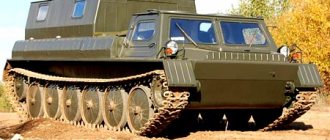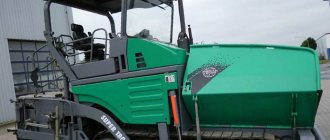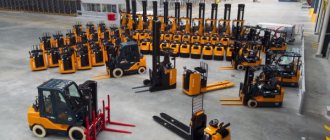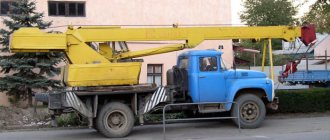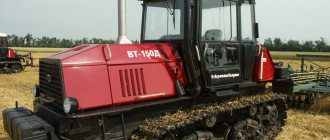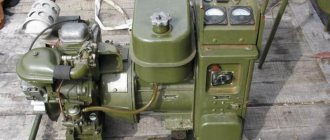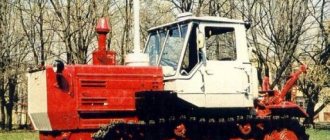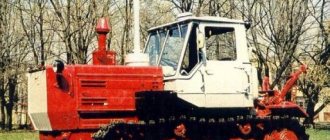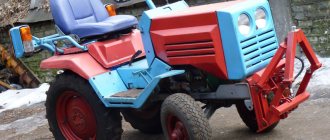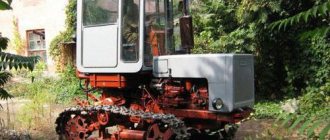TDT-55: technical characteristics, design, cost
The Great Patriotic War ended.
The country had to rebuild a deeply damaged economy. In 1946, Leningrad scientists specializing in this area came to the OGK NKTP with a request to develop a special tractor for forestry work, which was simply necessary for the forestry industry, which supplies wood for restoration construction projects in the country. As a result of long disputes, it was decided to use the developments on the tractor, designed during the war, in the OM design bureau under the leadership of B. Kashpersky. It was based on a captured German RSO.
Pictured: RSO on the Eastern Front. Winter 1943
Translated, it sounds like “a tractor going to the East.” It was specially designed as a high-clearance tracked vehicle for movement in difficult conditions of Russian weather and its difficult roads. It was used by the Wehrmacht as an artillery tractor. It was distinguished by: great unpretentiousness in operation, high maneuverability, ease of operation and omnivorous choice of fuel.
In August 1947, the design documentation for the vehicle was corrected. The fact is that the delivery of petroleum products to logging sites is a rather difficult process. But wooden logs were in abundance. Therefore, all vehicles had to be equipped with ZIS-21 gas generator units. The result of fierce debate was the recognition of the need to install a winch to bundle sawed wood trunks.
January 1949 marked the beginning of mass production of a new tractor - KT12, and a year later, a machine equipped with a diesel engine was born. Unfortunately, due to an acute shortage of such engines, it never reached mass production.
In 1956, the Onega Tractor Plant re-entered operation and the skidder, under the new name TDT-40, went to work. Over time, Onega engineers assessed all the shortcomings inherent in the machine and in 1962, they developed the following replica, the outdated TDT-55 tractor. It had a difficult birth; only in 1966 did large-scale production of the new product begin.
The machine was developed on the basis of the TDT-40, which was once so necessary, but did not solve all the problems of forestry. Design bureau designers studied the problems and requests of foresters, and by 1962 the first TDT-55 was assembled. He had to pass a whole set of tests before getting a “start in life.” In 1964, a new production line was built especially for it. In the new Onezhets, which is exactly the name it received, everything necessary was created: high reliability, high cross-country ability, the ability to operate reliably in any conditions. The tractor is able to work: in the temperature range from -40 to +40, in off-road conditions, on mountain slopes and marshy soils.
TDT-55 tractor
This unit began production at the Onega Tractor Plant, located in Petrozavodsk, in 1966. It replaced the outdated TDT-40 trader and was discontinued only after 37 years, giving way to more modern models.
The 55 series was characterized by its simplicity of design, excellent performance and high traffic. The developers did their best by removing unnecessary mechanisms that often broke down. Improvements to the transmission and the use of a more powerful engine were immediately brought to the fore, immediately resulting in a forty percent increase in throughput.
Destination
The main task of the domestic TDT-55 tractor is to remove felled trees from the felling site. The skidder can move large and medium-sized trunks, stack and load them, straighten clods, chop knots, plant whips and clear areas. In general, he gets all the toughest cutting jobs. Neither heat of plus 40, nor frost of minus 40 are an obstacle to this. the car can easily withstand them.
Development and release features
For a long time, the plant offered earlier versions of the TDT-55. At the same time, the Onega Tractor Plant offered vehicles ideal for performing various tasks. Active work to improve technical parameters began in the 1960s, as the TDT-40 and its modifications no longer met the requirements.
As a result, the plant designers designed the TDT 55 model, which became conceptually new. In 1962, the vehicle underwent special testing at the state level and began to be successfully used for most events. In addition, since 1964, mass production of the model began, taking into account the requirements of the transport market and the intended functionality. To achieve this, we modernized the design, increased productivity and reliability.
Main technical characteristics of TDT-55
The developers managed to find out the reasons for the failures of previous versions of the machines, and the new technical characteristics of the TDT-55 skidder managed to outperform its predecessor, the 40th model, in terms of functionality. This made it possible in later modifications, for 40 years (until 2004), to leave all the characteristics of the tractor unchanged.
Let's take a closer look at the technical indicators of the machine, according to those provided for by the TDT-55 tractor control system:
| Name | Data |
| Traction class | 3rd |
| Weight of the TDT-55 tractor, without attachments and load | 9600 kg |
| Height to cab roof | 2560 mm |
| Width, based on maximum roller data | 2357 mm |
| Length, including built-in bucket | 5800 mm |
The main feature of the machine’s overall dimensions is its increased performance in dense forest conditions, which does not allow other equipment to develop to their full potential. In this series, it was possible to solve the issue of effective maneuverability by optimizing the rotation parameters of the vehicle length.
Engine for tractor TDT – 55
Many operators do not fully understand why the clutch on the TDT-55 tractor moves? To do this, you need to refer to the functional characteristics of the engine itself. The heart of the machine is the internal combustion engine, which bears the manufacturer’s marking SMD-14B. (manufacturer from Ukraine, Kharkov,).
Basic technical information of the motor
TDT-55
TDT-55
— a caterpillar skidding tractor designed for removal and stacking of medium and large timber. Adapted for working in difficult forest conditions.
Produced since 1966 at the Onega Tractor Plant. In October 2003, the model was discontinued. This tractor has proven itself to be unpretentious in operation and maintainable in almost any conditions.
Content
Engine[edit]
The TDT-55 was equipped with SMD-14BN, SMD-18N, D-245 (later produced) engines, four-cylinder with or without supercharging. As a rule, SMD-18 engines, due to the complexity of maintenance and operation, were converted to SMD-14. At the same time, the cylinder-piston group was changed, the high-pressure fuel pump was reconfigured, and the turbine compressor was removed (due to the use of low-quality fuels and lubricants). Relatively weak SMD engines, as a rule, had a short TBO.
Dimensions, weight TDT-55A
When developing the TDT-55A, the designers chose an elastic suspension. The track rollers were installed on small balancers. Those, in turn, were connected to the frame using levers, which were hinged and rested against the bearing of the spark plug spring (the lower part of the frame). All this helped ensure that when the vehicle moved over obstacles, the separation of the road wheels from the tracks was minimal. The drive wheels were made single-rimmed, the guide wheels had one flange.
It is worth mentioning one more feature of the tractor. To improve ride quality and maneuverability, as well as more efficient operation of rear attachments, the chassis suspension has been moved rearward. But at the same time, this solution limited the mass of the front linkages.
Device
Engine
The tractor engine is diesel, four-stroke, linear, four-cylinder, turbocharged and liquid-cooled. The D-245 diesel was used in more modern installations, and earlier models were equipped with the SMD-18N-01 or SMD-14BN engine. It is located in front of the frame.
Transfer method
The clutch (with two dry discs) is located in the diesel flywheel housing, to which the gearbox is attached. There is a front brake. When the clutch
turned on, a special locking mechanism is activated, which prevents gear shifting. In total, this model has five forward gears and one reverse gear.
Chassis
The suspension on the tractor is of the lever-balance type, it is spring-loaded using a spring. It flexibly connects the tractor frame and wheel rollers, which provides shock absorption and shock absorption. The steering wheel has a crank mechanism that allows you to change the tension on the tracked tractor, as well as a shock absorber that protects the chassis from overload (if something gets stuck in the track). Diagram of the TDT-55 tractor 1. TDT-55 tractor; 2. frame; 3. arrow; 4. wheel rollers; 5. hydraulic cylinder; 6. lower rotating jaw; 7. jaw rotation mechanism; 8. upper movable jaw; 9. interior cover; 10. protective peak; 11. boom rotation mechanism; 12. main hydraulic cylinder; 13. auxiliary hydraulic cylinder; 14. transmission housing.
Steering
To disengage the clutch
(when you need to stop the car or change gear), use the special pedal located on the floor. The control drive of this clutch is connected to a hydraulic booster, which facilitates control.
Performance indicators
| Excavator JCB 130 – swamp vehicle for sale |
| ZIL 130, 6,000 cc. cm., 6,000 kg., 4×2 |
| ZIL-130, 6,000 cubic meters. cm., 6,000 kg., 4×2 |
| ZIL 130, 4,250 cc. cm., 1,000 kg., 4×2 |
| Zil 130, 7,700 cc. cm., 3,000 kg., 4×2 |
| Zil 130, 7,700 cc. cm., 3,000 kg., 4×2 |
| ZIL 130, 24,500 cc. cm., 56,000 kg., 4×2 |
| ZIL 130, 6,000 cc. cm., 6,000 kg., 4×2 |
| Selling ZIL 130, 6,000 cc. cm, 5,000 kg. |
| Ammann ASC130 soil compactor |
| Urgently selling Zil 130, 6,000 cubic meters. cm. |
| Ammann ASC 130 soil compactor |
| Selling bulldozer T-130, 15,000 kg. |
| Selling dump truck ZIL 130, 4×2 |
| ZIL-130, 1,000 cu.m. cm., 3,500 kg., 6×6 |
| Hitachi ZX130 boom repair kit |
| ZIL-130 manipulator, 3,000 cubic meters. cm., 5,000 kg., 4×2 |
| For sale Zil 130, 1,200 cubic meters. cm., 3,000 kg., 4×4 |
| Bulldozer T130, 14,680 cubic meters. cm, 18,000 kg. |
| Bulldozer T-130, 14,000 cubic meters. cm, 12,720 kg. |
| Bulldozer T-130, 3,000 cubic meters. cm, 5,000 kg. |
| Selling Zil 130, 6,000 cubic meters. cm, 4×2 |
| Single drum compactor Ammann ASC 130D |
| Tandem roller Ammann AV 130X |
| Selling ZIL-130, 6,000 cubic meters. cm, 10,850 kg. |
| Truck crane QY130K, 12,000 cubic meters. cm. |
| Wheeled excavator Hitachi 130, 1.00 cu.m. m. |
| Road roller Ammann ASC 130D |
| Roller Hamm 130 2007, 3,000 cubic meters. cm. |
| ZIL 130, 6,000 cc manipulator for sale. cm., 5,000 kg., 4×2 |
| Selling ZIL 130 Dump truck, 6,000 cubic meters. cm., 4 500 kg., 4×2 |
| Selling ZIL 130 Kolkhonik, 5,700 cc. cm., 5,000 kg., 4×2 |
| Truck ZIL 130, 6,000 cubic meters for sale. cm., 5,000 kg., 4×2 |
| Bulldozer T-130, 14,480 cubic meters for sale. cm, 14,320 kg. |
| Excavator JCB JS130 LC, 2008 |
| ZIL 130 KS2571 crane, new from storage |
| Aerial platform ZIL 130 AP-17, 4,600 cubic meters. cm, 17.00 m. |
| Hitachi LX130 wheel loader, Diesel, 3.00 cu.m. m. |
| Double drum roller Ammann AV 130X |
| Road milling machine Wirtgen W 130 CFi |
| New Holland HBM BG130, 6,600 cc cm. |
| Selling Zil 130 dump truck, 6,000 cubic meters. cm., 4,000 kg., 4×2 |
| I am selling a car ZIL -130, 2,400 cc. cm., 4,000 kg., 4×2 |
| Selling aerial platform ZIL-130 AGP-18.04, 18.00 m. |
See all advertisements in the archive
| Index | Unit | Meaning |
| Type | — | crawler |
| Traction class | — | 3 |
| Complete weight: Structural operating | kg |
Evgeniy, 39 years old:
“I work as a skidder in Taiga, I’ve been driving a TDT-55 for 7 years now. The vehicle’s cross-country ability is excellent - through swamps, through Taiga, and through sandstones - it rushes in the given direction without fail. Speed up to 15 km/h when loaded. Hydraulics greatly simplifies life - you don’t have to waste effort on steering. There were breakdowns, but the second circuit saved me with the pumps - I calmly crawled to my destination. Spare parts can always be obtained; there were no problems with repairs.”
Oleg, 42 years old:
“An excellent functional machine, simply irreplaceable in construction and when laying roads. Our construction company has exactly this. Very reliable equipment, easy to operate and unpretentious. Repairs are not cheap, but they pay for themselves quickly.”
